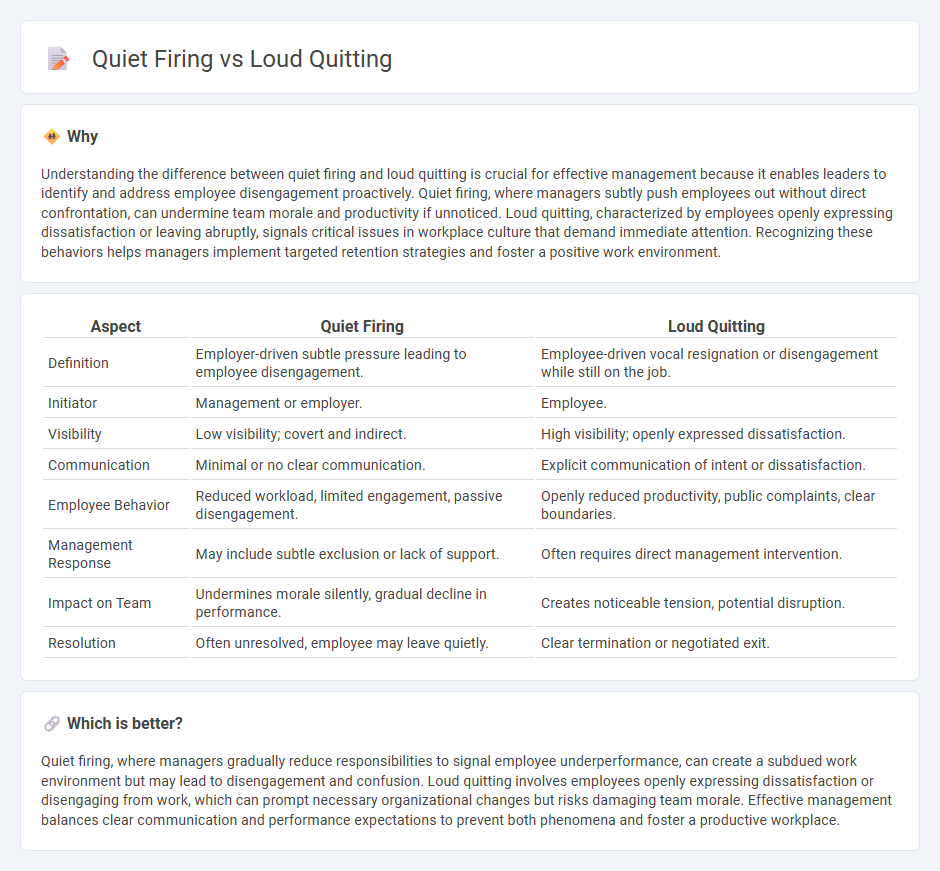
Quiet firing, a subtle management tactic where employers limit opportunities and resources to encourage employees to leave voluntarily, contrasts sharply with loud quitting, where employees openly disengage and express dissatisfaction at work. Understanding these opposing behaviors is essential for improving workplace culture and retaining talent. Explore how organizations can address and balance these dynamics for better management outcomes.
Why it is important
Understanding the difference between quiet firing and loud quitting is crucial for effective management because it enables leaders to identify and address employee disengagement proactively. Quiet firing, where managers subtly push employees out without direct confrontation, can undermine team morale and productivity if unnoticed. Loud quitting, characterized by employees openly expressing dissatisfaction or leaving abruptly, signals critical issues in workplace culture that demand immediate attention. Recognizing these behaviors helps managers implement targeted retention strategies and foster a positive work environment.
Comparison Table
| Aspect | Quiet Firing | Loud Quitting |
|---|---|---|
| Definition | Employer-driven subtle pressure leading to employee disengagement. | Employee-driven vocal resignation or disengagement while still on the job. |
| Initiator | Management or employer. | Employee. |
| Visibility | Low visibility; covert and indirect. | High visibility; openly expressed dissatisfaction. |
| Communication | Minimal or no clear communication. | Explicit communication of intent or dissatisfaction. |
| Employee Behavior | Reduced workload, limited engagement, passive disengagement. | Openly reduced productivity, public complaints, clear boundaries. |
| Management Response | May include subtle exclusion or lack of support. | Often requires direct management intervention. |
| Impact on Team | Undermines morale silently, gradual decline in performance. | Creates noticeable tension, potential disruption. |
| Resolution | Often unresolved, employee may leave quietly. | Clear termination or negotiated exit. |
Which is better?
Quiet firing, where managers gradually reduce responsibilities to signal employee underperformance, can create a subdued work environment but may lead to disengagement and confusion. Loud quitting involves employees openly expressing dissatisfaction or disengaging from work, which can prompt necessary organizational changes but risks damaging team morale. Effective management balances clear communication and performance expectations to prevent both phenomena and foster a productive workplace.
Connection
Quiet firing and loud quitting are interconnected workplace phenomena reflecting deteriorating employee-manager relationships and organizational disengagement. Quiet firing involves subtle managerial tactics that discourage employee growth and retention, while loud quitting represents employees openly reducing effort or resigning in response to perceived undervaluation. Both concepts highlight critical challenges in management practices that impact turnover rates, productivity, and corporate culture.
Key Terms
Employee Engagement
Loud quitting, characterized by employees openly expressing dissatisfaction and disengagement, contrasts with quiet firing, where employers subtly encourage an employee to leave through decreased engagement and support. Both phenomena significantly impact employee engagement by either diminishing morale or eroding trust within the workplace. Explore effective strategies to enhance employee engagement and address these challenges for a healthier organizational culture.
Organizational Communication
Loud quitting involves employees openly expressing dissatisfaction and disengagement, signaling breakdowns in organizational communication and workplace culture. Quiet firing occurs when management subtly discourages employee retention through unclear expectations or lack of support, reflecting indirect communication strategies that impact morale. Explore effective organizational communication techniques to address and prevent both loud quitting and quiet firing scenarios.
Workplace Culture
Loud quitting refers to employees openly expressing dissatisfaction by dramatically resigning or voicing concerns, often highlighting toxic workplace culture issues. Quiet firing, on the other hand, involves employers subtly pushing employees out through exclusion, reduced responsibilities, or limited growth opportunities, reflecting a lack of transparent communication and support. Explore more about how workplace culture shapes these contrasting phenomena and influences employee retention.
Source and External Links
Loud Quitting: What It Is and How To Address It - This article discusses the concept of loud quitting, its warning signs, and strategies for addressing it in the workplace.
Loud quitting - Loud quitting is a form of employee disengagement where individuals openly express discontent and intent to leave, often publicly on social media.
What is Loud Quitting: Causes, Effects & How to Deal With It - This page explains the causes and effects of loud quitting, different forms it can take, and strategies for companies to prevent it.
 dowidth.com
dowidth.com